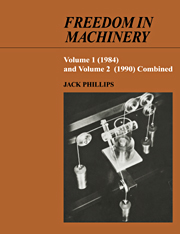Book contents
- Frontmatter
- Dedication
- Contents
- Preface
- General introduction
- 1 Mechanism and the mobility of mechanism
- 2 Overconstraint and the nature of mechanical motion
- 3 Some of the various lines in a moving body
- 4 Enumerative geometry and the powers of infinity
- 5 Rigidity and the instantaneous screw axis
- 6 Irregularity and the freedoms within a joint
- 7 The possibilities in reality for practical joints
- 8 Some elementary aspects of two degrees of freedom
- 9 The linear complex of right lines in a moving body
- 10 Line systems and the dual vectors in mechanics
- 11 Geometrical properties of the linear line systems
- 12 The vector polygons for spatial mechanism
- 13 On the two theorems of three axes
- 14 Some reciprocities across the middle number three
- 15 The generality and the geometry of the cylindroid
- 16 The discovery in a mechanism of a cylindroid
- 17 Action, notion, clearances and backlash
- 18 Singular events in the cycles of motion
- 19 Fundamental relations and some algebraic methods
- 20 The special geometry of some overconstrained loops
- 21 The helitangent lines in a moving body
- 22 The cylindroid in gear technology
- 23 The general and the special screw systems
- Bibliography
- Index of proper names
- Subject Index
1 - Mechanism and the mobility of mechanism
Published online by Cambridge University Press: 07 September 2010
- Frontmatter
- Dedication
- Contents
- Preface
- General introduction
- 1 Mechanism and the mobility of mechanism
- 2 Overconstraint and the nature of mechanical motion
- 3 Some of the various lines in a moving body
- 4 Enumerative geometry and the powers of infinity
- 5 Rigidity and the instantaneous screw axis
- 6 Irregularity and the freedoms within a joint
- 7 The possibilities in reality for practical joints
- 8 Some elementary aspects of two degrees of freedom
- 9 The linear complex of right lines in a moving body
- 10 Line systems and the dual vectors in mechanics
- 11 Geometrical properties of the linear line systems
- 12 The vector polygons for spatial mechanism
- 13 On the two theorems of three axes
- 14 Some reciprocities across the middle number three
- 15 The generality and the geometry of the cylindroid
- 16 The discovery in a mechanism of a cylindroid
- 17 Action, notion, clearances and backlash
- 18 Singular events in the cycles of motion
- 19 Fundamental relations and some algebraic methods
- 20 The special geometry of some overconstrained loops
- 21 The helitangent lines in a moving body
- 22 The cylindroid in gear technology
- 23 The general and the special screw systems
- Bibliography
- Index of proper names
- Subject Index
Summary
Some opening remarks
01. Some successful mechanical devices function smoothly however poorly they are made, while others do this only by virtue of the accurate construction and fitting of their moving parts. In this chapter I try to quantify such phenomena. The term mechanism is introduced, and I allow some ambiguity about the exact meaning of it. I speak about links and joints, and discuss the elementary principles of freedom and constraint in mechanism, mentioning some of the difficulties met. We find that, while acceptable analyses of existing mechanism can often be made quite easily, we cannot without insight and imagination make effective syntheses of new mechanism. A range of relevant abstractions is made, some quantifications are proposed, and criteria are established for the mobility of mechanism. This then becomes the main subject for study. It needs to be explained however that mobility is not related with matters of mass, inertia, acceleration, or the natural laws of Newton.
02. All matters of dynamics in the mechanics of mechanism, and these have just been mentioned parenthetically, are immensely important in the successful design of working machinery. They are however ignored in the pure geometrical considerations which follow soon. I am dealing exclusively in chapter 1 with the kinematics of machinery. Yet, as soon as one thinks of a moving, massless mechanism transmitting power, with work being done as the forces are transmitted, one begins to see that the kinematics of the relative motions on the one hand, and the statics of the transmitted forces on the other, are always related in machinery (§ 13.04).
- Type
- Chapter
- Information
- Freedom in Machinery , pp. 6 - 25Publisher: Cambridge University PressPrint publication year: 2007



